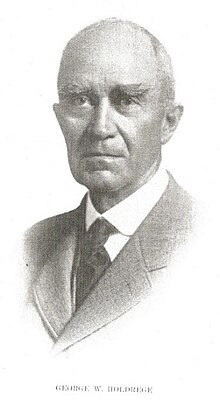

 | Review waiting, please be patient.
This may take 4 months or more, since drafts are reviewed in no specific order. There are 2,939 pending submissions waiting for review.
Where to get help
How to improve a draft
You can also browse Wikipedia:Featured articles and Wikipedia:Good articles to find examples of Wikipedia's best writing on topics similar to your proposed article.
Improving your odds of a speedy review To improve your odds of a faster review, tag your draft with relevant WikiProject tags using the button below. This will let reviewers know a new draft has been submitted in their area of interest. For instance, if you wrote about a female astronomer, you would want to add the Biography, Astronomy, and Women scientists tags.
Editor resources
Reviewer tools
|
George Ward Holdrege
| |
|---|---|

Portrait of George Ward Holdrege from "Omaha the Gate City, and Douglas County, Nebraska", 1917
| |
| Born | (1847-03-26)March 26, 1847
New York City, NY, U.S.
|
| Died | September 14, 1926(1926-09-14) (aged 79)
Omaha, Nebraska, U.S.
|
| Alma mater | Matriculated Harvard |
| Occupation(s) | Railroad officer, land owner |
| Spouse |
Emily Cabot Atkinson
(m. 1872)Francis Rodgers Kimball
(m. 1878) |
| Children | 4 |
George Ward Holdrege (March 26, 1847 - September 14, 1926) was an American railroad officer and cattle rancher with large land holdings in western Nebraska. An early advocate of modern agricultural practices, he experimented with irrigation, dryland farming methods, soil conservation, and crop rotation.[1]
Born in New York City on March 26, 1847, he was the second son of Henry Holdrege Jr. and Mary Russell Grennell Holdrege. His father was employed by the New York Commission Mercantile Firm of Grinnell, Minturn & Company. Through his mother’s family, George had a heritage that connected him with some of the oldest and most illustrious New England families: Grinnell, Russell and Howland.
In 1850, the family left the crowded New York City metropolitan area and established a family home at Irvington-on-Hudson, in Westchester County. At sixteen, George attended a small, private day school in Boston operated by William Parsons Atkinson, one of the original faculty members of Massachusetts Institute of Technology. In June of 1865, he graduated from Atkinson’s school and spent the summer in Cambridge preparing for his entrance into Harvard. There, he was a member of the University Boat Club in 1867 and 1868. After his father’s business failed in 1869, George returned home and never graduated.[2]
On February 12, 1872, Holdrege married Emily Cabot Atkinson at Boston, Massachusetts. Her death, on February 16, 1873, followed the birth of a son, Henry Atkinson Holdrege. In Omaha on April 23, 1878, George was married to Francis Rodgers Kimball, sister of noted architect, Thomas Rogers Kimball. They became the parents of three daughters: Mrs. Mary Holdrege Holyoke; Mrs. Susan Holdrege Hollister; and Leeta Holdrege.
While visiting Clifford Watson, a friend in Boston, in 1869, George secured a job interview with railroad magnet John Murray Forbes, who offered him a position with his new railroad in Nebraska. George moved to Plattsmouth, Nebraska, and was employed as a railroad clerk for the Burlington and Missouri River Railroad Company (B &M). He advanced steadily, serving as assistant paymaster, brakeman, conductor, trainmaster and assistant superintendent. In 1882, he was appointed General Manager. During his career, the B & M Railroad in Nebraska expanded from 495 miles of track to 4,713 miles, including the completion of a line from Grand Island through the Sandhills to Sheridan, Wyoming.
With the arrival of the B & M Railroad at Sheridan, coal mines were developed along the Tongue River. Anson Higby formed the Sheridan Fuel Company and when midwestern capitalist Gould Dietz became the treasurer of the company, the name of the camp was changed to Dietz[3]. Dietz and Holdrege collaborated with Omaha architect Thomas Rogers Kimball to create the Dome Lake Club, high in the Big Horn Mountain range. It was constructed after the railroad sent a scouting party led by surveyor Edward Gillette, who in 1884 was in charge of locating the most economical route for the railroad by investigating grade, distance, and other factors[4]. Holdrege’s rail extensions began in Nebraska, worked up through the Black Hills of present-day South Dakota, and into Wyoming Territory with extensions reaching Billings, Montana.[5]
George Holdrege extensively invested in Nebraska panhandle ranchland. He owned the famed HO ranch in Perkins County and upon retirement bought another ranch on the White River, near Chadron, Nebraska. As pioneers began to settle along the land areas newly opened up by the B & M lines, he became convinced that the railroad should become active in increasing the agricultural and mining production of the area it served. To this end, the railroad developed an experimental farm, irrigation service, and free transportation of the grain produced to market. He hired Hardy Webster Campbell[6], a dry farming expert, as an agricultural agent for the B & M Railroad.[7]
Upon his retirement on December 31, 1920, George was lauded for his pioneer efforts. Long publicly recognized as a central figure in legislative debates at the Nebraska State Capitol in Lincoln, George was awarded a “service medal” by the Lincoln Kiwanis Club in 1925. The town of Holdrege, in Phelps County, is also named for him. He suffered a heart attack at his home in Omaha and died on September 14, 1926.[8] George Ward Holdrege is interred at Wyuka Cemetery, Lincoln, Lancaster County, Nebraska.
The town of Holdrege in Phelps County, Nebraska is named in his honor.
He was a member of the Unitarian Church, Omaha Chamber of Commerce, and the Omaha Club.[7]
In 1965, he was inducted into the Hall of Great Westerners; created to celebrate the contributions of more than 200 men and women of the American West.[1]
Category:People from New York, NY Category: Predecessors of the Chicago, Burlington and Quincy Railroad Category: American West museums Category:Businesspeople from Omaha, Nebraska Category:1847 births Category:1926 deaths